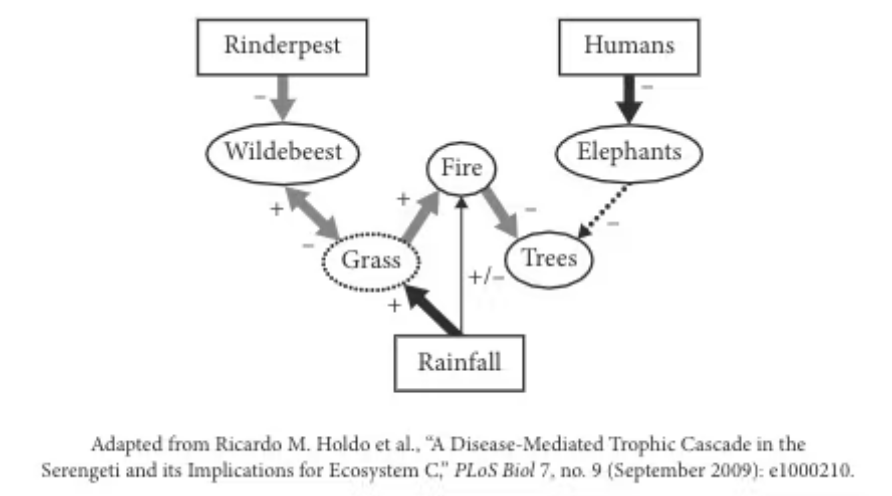AP Biology Practice Questions 2
/in AP Biology /by adminAP Biology Free Practice Question #1
The figure below shows a model generated from a study of interactions in a Serengeti ecosystem. This figure describes hypothesized relationships between a parasite that causes disease in wildebeest, rinderpest, and other important components of the ecosystem. Thick arrows represent dominant effects, and “grass” is in a dotted circle because that variable was not directly measured in the study.

Which of the following can most reasonably be predicted based on this figure?
A: Increasing the amount of rinderpest would decrease the amount of grass.
B: Increased fire would lead to higher tree and elephant populations.
C: Increasing the amount of rinderpest could indirectly lower tree numbers.
D: Increased human populations have a net positive effect on the elephant population.
Answer 1
C: Increased rinderpest prevalence would lower wildebeest populations, increasing the amount of grass (because wildebeests feed on the grass) and providing more mate-rial to start and spread fires, thereby decreasing the number of trees. Choice (C) is thus correct. Choice A is incorrect because more rinderpest means fewer wildebeests, which in turn leads to more grass. Choice B is incorrect because fire reduces the tree population. Choice D is incorrect because the figure suggests that humans have only an adverse effect on the elephant population.
AP Biology Free Practice Question #2
Human red blood cells lack mitochondria. Which of the following correctly explains the primary pathway that red blood cells use to produce energy?
A: Red blood cells generate ATP and NADH via aerobic respiration.
B: Red blood cells generate ATP and NADH via anaerobic fermentation.
C: Red blood cells metabolize glucose via glycolysis followed by carbon dioxide and ethanol production to produce ATP.
D: Red blood cells produce ATP via glycolysis followed by lactic acid production.
Answer 2
D: Lacking mitochondria, red blood cells predominantly produce energy by anaerobic respiration. Thus, red blood cells produce ATP via glycolysis followed by lactic acid fermentation. The correct answer is (D). Choice A is incorrect because aerobic cellular respiration occurs in mitochondria, which red blood cells lack. Choice B is incorrect because the products of anaerobic fermentation are ATP and NAD+ (glycolysis produces ATP and NADH, and fermentation regenerates NAD+). Choice C is incorrect because human red blood cells undergo lactic acid fermentation, not alcohol fermentation.
AP Biology Free Practice Question #3
Before a cell can undergo cellular division, it must progress through an interphase stage in which the cell matures and produces proteins needed for division. Which of the following best describes the interphase stage?
A: The cell grows, replicates its DNA, and prepares to divide during interphase. If a genetic mutation is introduced during interphase and not repaired, the daughter cells will inherit the mutation.
B: The cell grows, replicates its DNA, and prepares to divide during interphase. None of the genetic mutations introduced during interphase are inherited by the daughter cells.
C: The cell replicates its DNA and prepares to divide during interphase, but does not grow. None of the genetic mutations introduced during interphase are inherited by the daughter cells.
D: The cell replicates its DNA and prepares to divide during interphase, but does not grow. If a genetic mutation is introduced during interphase and not repaired, the daughter cells will inherit the mutation.
Answer 3
A: During the 3 stages of interphase (G1, S, and G2), there is pronounced growth, DNA replication, and crucial preparation for cellular division. DNA replication errors during this process, if not detected and fixed, would result in mutations being passing on to daughter cells. (A) is thus correct. (B) is incorrect because unrepaired mutations would be passed on. (C) and (D) are incorrect because cells do in fact grow during interphase.
AP Biology Free Practice Question #4
Saturated fats have a high melting point and remain solid at room temperature. Unsaturated fats are liquid at room temperature and solidify at much lower temperatures than saturated fats. In order for the membrane to function properly, membrane fluidity must stay within a certain physiological range. Chemical analysis of membrane lipids in bacteria adapted to different temperature ranges is shown in the table below.
Which of the following conclusions can be reasonably drawn from the data provided in the table?

A: The composition of phospholipids in the membrane is not correlated to ambient temperature.
B: Bacteria that thrive in cold environments adapt by increasing membrane rigidity.
C: The membranes of G. stearothermophilus are adapted to increase fluidity at high temperatures.
D: Fatty acids in B. psychrophilus allow the membrane to maintain its fluidity at low temperatures.
Answer 4
D: Based on the information provided, cell membranes require a significant proportion of unsaturated fatty acids in order to maintain fluidity at low temperatures. Thus, B. psychrophilus needs to contain a larger proportion of unsaturated fatty acids because it tends to be found at lower temperatures, making (D) correct. (A) is incorrect because there is a correlation found in the table: temperature is inversely correlated with unsaturated fatty acid content. (B) is incorrect because bacteria in colder environments require additional fluidity, not additional rigidity. (C) is incorrect because the high temperatures that G. stearothermophilus is exposed to require greater rigidity, not greater fluidity, which is why the species contains such a small proportion of unsaturated fatty acids.
AP Biology Free Practice Question #5
Which of the following conclusions can most reasonably be drawn if a host cell’s function has been impaired following a viral infection?
A: The host cell will lyse or undergo apoptosis regardless of the severity of damage.
B: The host cell will lyse or undergo apoptosis if the severity of damage exceeds the cell’s ability to repair itself.
C: The host cell will only lyse.
D: The host cell will only undergo apoptosis.
Answer 5
B: If a cell loses its ability to function and cannot be repaired, then it could lyse (burst open) or undergo apoptosis (programmed cellular death). Whether it does either depends on the severity of the damage to the cell. Choice (B) is thus correct. Choice A is incorrect because the cell will remain intact if it is capable of repairing the damage. Choices C and D are incorrect because they only present one of the two viable options for a damaged cell.
Click here for more AP Biology practice questions.

